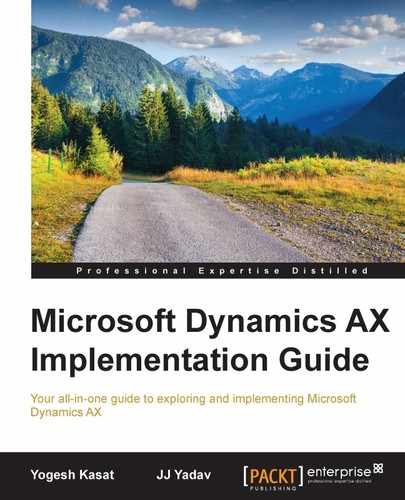In any ERP implementation project, you deal with multiple environments. For example, you start with CRP; after the development you move to the test environment, and then training, UAT, and production, as shown in the following diagram:

One of the biggest challenges that an implementation team faces is moving the configuration from one environment to another. If configurations keep changing in every environment, it becomes more difficult to manage them. Similar to code promotion and release management across environments, configuration changes need to be tracked through a change-control process across environments to ensure that you are testing with a consistent set of configurations.
The objective is to keep track of all the configuration changes and make sure that they make it to the final cut in the production environment.
The following sections outline some approaches used for configuration data management in the Dynamics AX project.
An environment that is pristine without any transactions—the golden environment—is sometimes referred to as a stage or pre-prod environment. Create the configurations from scratch and/or use various tools to create and update the configuration data. Develop a process to update the configuration in the golden environment once it has been changed and approved in the test environments.
The golden environment can be turned into a production environment or the data can be copied over to the production environment using database restore.
The golden environment database can be used as a starting point for every run of data migration. For example, if you are preparing for UAT, use the golden environment database as a starting point. Copy to UAT and perform data migration in your UAT environment. This would ensure that you are testing with the golden configurations (if the configuration is missing in the golden environment, you would be able to catch it during testing and fix your UAT and the golden environment too).
The pros of the golden environment are given as follows:
- The golden environment is a single environment for controlling the configuration data
- You can use all the tools available for the initial configuration
- There is a lessened chance of the corruption of configuration data
The cons of the golden environment are given as follows:
- There is a risk of missing configuration updates due to not following the processes (as the configuration updates are made directly in the testing and UAT environments)
- There are chances of migrating the revision data into the production environment like workflow history, address revisions, and policies versions
- There is a risk of migrating environment-specific data from the golden environment to the production environment
- This is not useful for a project going live in multiple phases, as you will not be able to transfer the incremental configuration data using database restore
- You must keep the environment in sync with the latest code
In this approach, the implementation team typically defines a template legal entity and configures the template company from scratch. Once completed, the template company's configuration data is copied over to the actual legal entity using the data export/import process.
This approach is useful for projects going live in multiple phases, where a global template is created and used across different legal entities. Whereas, in AX 2012, a lot of configuration data is shared, and it makes it almost impossible to copy the company data.
In this approach, the implementation team typically builds a repository of all the configurations done in a file, and then imports them in each subsequent environment, and finally, in the production environment.
The pros of building configuration templates are as follows:
- It is a clean approach
- You can version-control the configuration file
- This approach is very useful for projects going live in multiple phases, as you can import the incremental configuration data in the subsequent releases
This approach may need significant development efforts to create the X+ scripts or DIXF custom entities to import all the required configurations.
